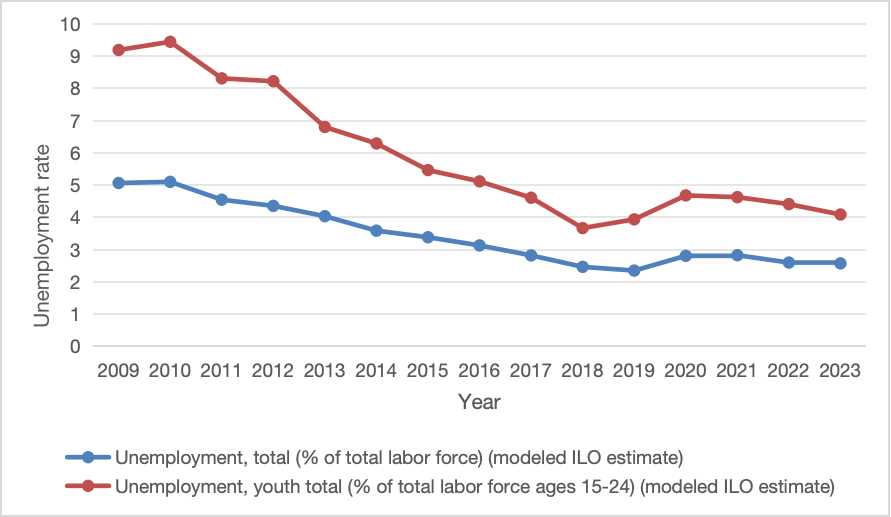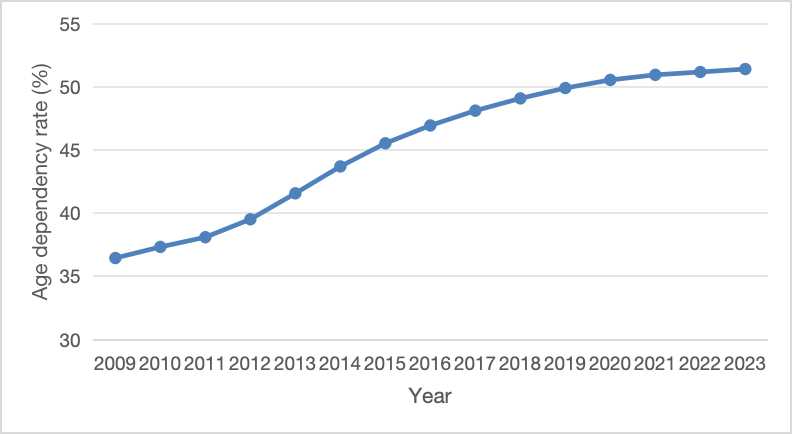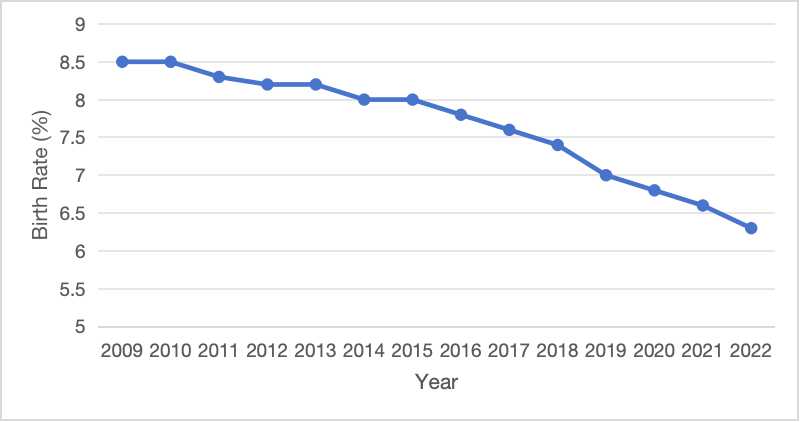1. Introduction
As one of the most developed economies in the world, Japan has been maintaining a steady growth all the time. However, influenced by the adjustment of Japanese society structure and labor market, some new challenges to Japanese economic development have appeared in recent twenty years. Among them, the reverse selection phenomenon in the employment of Japanese university graduates has gradually come into the focus of scholars' extensive attention. Research in Japan's labor market is indispensable for understanding the influence of economic growth dynamics and constraints. Due to issues such as a lack of labor and an aging society, Japan is finding itself recently not only under pressure for economic growth but also in urgent need to optimize the allocation of labor resources. If substantial policy recommendations are to be made, it would therefore be important to explore the behavior of university graduates in the job market and their resulting impact on the economy.
Japan has made some progress in terms of gender equality, labor force participation rate, and the impact of technological change on employment. Although gender equality has improved in recent years, women still face significant wage gaps and inadequacy in leadership positions [1]. In terms of labor force participation, there has been an increasing trend, particularly among women and the elderly, largely driven by policies aimed at addressing population aging and declining birth rates [2]. Technological change, especially automation and artificial intelligence, has had a dual effect on employment, leading to creation of jobs in emerging sectors, which may help japan to alleviate the impact of labor shortage caused by the aging of population. However, the job losses in certain industries is also a challenge for the policy makers [3].
However, there remains relatively little study on the reverse selection phenomenon among university graduates. This issue affects not only the quality of employment for these graduates but also has profound implications for the overall labor supply and resource allocation in the economy. This study aims to analyze cases of reverse selection among university graduates and their impact on the economy, proposing corresponding policy recommendations. Specifically, this study investigates the driving factors behind university graduates' employment decisions during the job search process and the mismatch between market supply and demand. Additionally, it assesses the long-term impact of this phenomenon on Japan's overall economy and provide empirical recommendations on how to improve policies to optimize the job market. Findings of this research offer valuable insights for Japan and other similar economies, helping to implement more effective labor market policies and promote sustainable economic development.
2. Reverse Selection in the Labour Market
2.1. Background Information
As shown in Figure 1, although Japan's youth unemployment rate has slightly declined, it remains significantly higher than the overall unemployment rate in recent years. This indicates that university graduates entering the labor market face greater employment pressure. In the background of high unemployment rates, the traditional lifetime employment system is gradually losing its attractiveness, leading university students to demonstrate a more flexible approach to career choices. They are now prioritizing career development prospects and work-life balance over merely pursuing the stability of large corporations. This phenomenon of university students actively selecting companies will help to lower youth unemployment rate, influencing students to reassess job opportunities and choose employers that better align with their personal development. At the same time, this trend is prompting companies to adjust their recruitment strategies, offering more flexible employment opportunities to attract and retain young talent.

Figure 1: Japan’s unemployment rate (total vs. age between 15-24; Data Source: World Bank).
According to a study in 2024, Japan's effective job-to-applicant ratio (the ratio of job seekers to available positions) reached 1.24, meaning that, on average, each job seeker had 1.2 job positions to choose from [4]. This phenomenon of supply exceeding demand is especially evident in certain industries, such as information technology and manufacturing. In this market environment, university students have more autonomy in their employment choices, with more students actively selecting companies that align with their values and career goals, rather than passively accepting offers from companies.
2.2. Root Cause Analysis
Several factors underlie the phenomenon of Japanese university students' actively selecting companies. First, Japan is facing a severe aging problem. According to Figure 2, the ratio of old-age dependency has increased from 2009 to 2023, from below 40% to above 50%. As the proportion of the elderly population continues to increase, the problem of labor shortage has become more serious, and society's demand for young labor has become more urgent to support the increasing burden of an aging society [5]. As the workforce declines, competition among companies for young talent has intensified, further enhancing the leverage university students have in the job market.

Figure 2: Age dependency rate (Data Source: World Bank).
Additionally, the appeal of the lifetime employment system has significantly declined among the younger generation. According to a survey, over 60% of young employees indicated a preference for short-term contract work or freelance positions to seek greater flexibility and personal development opportunities [6]. This trend reflects a shift away from traditional work concepts among young people, who now place more importance on work-life balance and diverse career development.
Moreover, Japan's economic recovery has further intensified the demand for labor. Japan's Gross Domestic Product (GDP) growth rate in 2023 was 2.1%, with particularly notable growth in emerging industries such as information technology, healthcare, and services [7]. The job growth rate in these industries, further driving university students' autonomy in job selection. In contrast, traditional industries such as manufacturing and construction are facing recruitment challenges, with some companies experiencing job vacancies [8].
2.3. Impact on the Labour Market
The phenomenon of university students actively selecting companies has had broad and far-reaching effects on Japan's labor market, causing changes in the industry structures. Data shows that the proportion of young people choosing to enter emerging industries has increased. This shift has led traditional industries, such as manufacturing and agriculture, to face dual pressures of an aging workforce and labor shortages. Additionally, the average age of Japan’s labor industry also rises to nearly 50 years old [9].
Moreover, company’s management models and cultures are also evolving. To attract young talents, more and more companies are introducing more flexible work arrangements, such as flexible working hours and remote work. For example, there are lots of financial institutions in Japan implementing a comprehensive remote work policy starting in 2022, resulting in an increase in job satisfaction rate [10]. These changes indicate that companies are gradually aligning with Western management styles, placing greater emphasis on employees' personal needs and work experiences.
However, from an economic perspective, the phenomenon of students actively selecting companies has also presented some challenges. Although companies have raised salaries to attract talents, the real purchasing power has not significantly improved due to inflation. For example, Japan’s national average wage increased by 2.5% in 2023, but the consumer price index rose by 3.2% during the same period. The wage growth failed to outpace inflation, leading to a slight decline in real income levels [11]. Additionally, despite the enhanced bargaining power for job seekers, intense competition for positions still exists in some competitive industries, such as information technology and finance.
3. Suggestions
According to Figure 3, Japan's crude birth rate has shown a downward trend from 2009 to 2022, which dropped from about 8.5 newborns per 1,000 females to about 7.0, reflecting a significant decrease in Japan's birth rate. The phenomenon not only represent a short-term imbalance in the labor market, but also reflects long-term issues such as low birth rates and labor shortages. To address these challenges, the government should further encourage childbirth by reducing the financial burden on families through measures such as providing childcare subsidies, tax reductions, and increasing childcare facilities.

Figure 3: Birth rate (Data Source: Ministry of Health, Labor, Welfare).
Meanwhile, immigration policies are another effective way to alleviate labor shortages. In recent years, Japan has begun to relax visa policies for certain skilled immigrants, but overall immigration policy remains relatively conservative. The government could further ease visa restriction policies to attract more foreign labor into the Japanese market, especially in high-demand sectors such as information technology and healthcare.
In the meantime, it is parallel to strengthen the efforts of reducing asymmetry of such information in order to promote the efficiency of the labor market. The government should try to establish more informational and communicational publicity platforms between firms and universities to improve integration. For example, it can create a nationwide online employment information system to make it easier for students to access job postings and companies to better understand their employment expectations and ability training.
Besides, it is necessary to further encourage enterprise cultural transformation. Through legislation and policy guidance, enterprises could be encouraged to be flexible and employee-friendly in management, such as adopting a flexible working hour system, paid leave system, etc. Such measures wouldn't only increase employees' satisfaction with their jobs but also attract more young people into companies, thus helping companies ensure long-term development.
4. Conclusion
With the activation of a new change in the labor market and as a social structure, the employment behavior of university graduates has become increasingly important. In this context, the present study tries to look into active selections by graduates in the job market, assess implications for such behavior on the overall economy, and offer targeted policy recommendations to better allocate labor resources.
This paper first elaborates on the very root of reverse selection. Added to the fact that Japan is facing a really grave aging problem, the logical result would be that with an increased proportion of elderly people in the population, the demand for a young workforce to support the burden of an aging society and hence competition among companies for young talent has increased. Besides, lifetime employment has lost much of its appeal; the young generation prefers short-term contracts or freelancing in favor of more freedom and possibilities for personal growth. Economic recovery in Japan propelled labor demand in emerging industries, while traditional industries have recruitment headaches.
The impact of college graduates actively choosing companies is far-reaching, causing a seismic shift in the very structure of the industry itself. It can be seen from the data that favored emerging industries by young people contribute to the double pressures brought by accelerated aging and labor shortage in traditional industries. Besides, for attracting more young people, companies are tapping management for better flexibility in work. However, while the companies are offering enhanced wages in order to compete for talent, because of inflationary pressures, real purchasing power has not surged upwards. As a matter of fact, even as the bargaining strength of job candidates has strengthened, the competition still remains quite incendiary in highly competitive industries that range from information technology to finance.
Faced with chronic labor market imbalances, the government should encourage fertility by promoting a series of policy measures to lighten the economic burden of families. Besides, immigration policies are surely an effective way to ease labor shortages in Japan. The more foreign labors will be attracted if the government further relaxes visa restrictions for those working in high-demand industries. The government should promote deeper cooperation between enterprises and universities by establishing more transparent and interactive information sharing platforms. These will not only raise the job satisfaction of all employees but also appeal to more young talents to develop together with the company for a longer period.
To conclude, the study provides insights into the phenomenon of active firm selection by Japanese university graduates and its economic effects. By addressing the current challenges that are catered for in relation to the best allocation of labor resources, it would make Japan and other similarly placed economies enjoy more sustainable economic growth and improve on the stability of the global economy.
References
[1]. Chowdhury, M. A. (2023) Workforce Decrease as a Solution for the Elderly, Women, and Immigrant in Japan's Labor Market. Kitakyushu Shiritsu Daigaku Hou-Sei Ronshu Journal of Law and Political Science, 3(4), 27-48.
[2]. Schoppa, L. J. (2020) The policy response to declining fertility rates in Japan: relying on logic and hope over evidence. Social Science Japan Journal, 23(1), 3-21.
[3]. Boutellier, O. and Juan, C. (2024) Artificial Intelligence (AI) May Not Solve Japan’s labor shortages: an unprecedented automation of knowledge-based jobs. Kumamoto University Studies in Social and Cultural, 22, 155-167.
[4]. Ministry of Health, Labour and Welfare, Japan. (2024) Japan Jobs to Applications Ratio. Retrieved from https://tradingeconomics.com/japan/jobs-to-applications-ratio.
[5]. Jones, R. S. and Seitani, H. (2019) Labour market reform in Japan to cope with a shrinking and ageing population. OECD Economics Department Working Papers No. 1568.
[6]. Debroux, P. (2022) Employment of senior workers in Japan. Contemporary Japan, 34(1), 58-86.
[7]. Mackey, T., Bekki, H., Matsuzaki, T. and Mizushima, H. (2020) Examining the potential of blockchain technology to meet the needs of 21st-century Japanese health care: viewpoint on use cases and policy. Journal of medical internet research, 22(1), e13649.
[8]. Kameno, J. (2023) Is Japanese Internship for the Purpose of Education or Recruitment?: A Study of its Historical Background, and Recent Changes and Future Challenges. Japan Labor Issues, 7(41), 19-34.
[9]. Ministry of Health, Labour and Welfare, Japan. (2019) Basic Survey on Wage Structure. Retrieved from https://www.mhlw.go.jp/english/database/db-l/ordinary.html.
[10]. Blind, G. D., Kotosaka, D. C. M. and von Mandach, S. L. (2022) Telework in a high-context culture: Lessons from a COVID-19 natural experiment in Japan. Working Paper Series in Social Science of Japan.
[11]. Chun, H., Fukao, K., Kwon, H. U. and Park, J. (2024). Why Do Real Wages Stagnate in Japan and Korea?. Asian Economic Papers, 23(1), 116-139.
Cite this article
Zhang,X. (2024). An Analysis of the Japanese Labor Market - A Case Study of University Students Actively Selecting Companies. Advances in Economics, Management and Political Sciences,143,1-6.
Data availability
The datasets used and/or analyzed during the current study will be available from the authors upon reasonable request.
Disclaimer/Publisher's Note
The statements, opinions and data contained in all publications are solely those of the individual author(s) and contributor(s) and not of EWA Publishing and/or the editor(s). EWA Publishing and/or the editor(s) disclaim responsibility for any injury to people or property resulting from any ideas, methods, instructions or products referred to in the content.
About volume
Volume title: Proceedings of ICFTBA 2024 Workshop: Finance's Role in the Just Transition
© 2024 by the author(s). Licensee EWA Publishing, Oxford, UK. This article is an open access article distributed under the terms and
conditions of the Creative Commons Attribution (CC BY) license. Authors who
publish this series agree to the following terms:
1. Authors retain copyright and grant the series right of first publication with the work simultaneously licensed under a Creative Commons
Attribution License that allows others to share the work with an acknowledgment of the work's authorship and initial publication in this
series.
2. Authors are able to enter into separate, additional contractual arrangements for the non-exclusive distribution of the series's published
version of the work (e.g., post it to an institutional repository or publish it in a book), with an acknowledgment of its initial
publication in this series.
3. Authors are permitted and encouraged to post their work online (e.g., in institutional repositories or on their website) prior to and
during the submission process, as it can lead to productive exchanges, as well as earlier and greater citation of published work (See
Open access policy for details).
References
[1]. Chowdhury, M. A. (2023) Workforce Decrease as a Solution for the Elderly, Women, and Immigrant in Japan's Labor Market. Kitakyushu Shiritsu Daigaku Hou-Sei Ronshu Journal of Law and Political Science, 3(4), 27-48.
[2]. Schoppa, L. J. (2020) The policy response to declining fertility rates in Japan: relying on logic and hope over evidence. Social Science Japan Journal, 23(1), 3-21.
[3]. Boutellier, O. and Juan, C. (2024) Artificial Intelligence (AI) May Not Solve Japan’s labor shortages: an unprecedented automation of knowledge-based jobs. Kumamoto University Studies in Social and Cultural, 22, 155-167.
[4]. Ministry of Health, Labour and Welfare, Japan. (2024) Japan Jobs to Applications Ratio. Retrieved from https://tradingeconomics.com/japan/jobs-to-applications-ratio.
[5]. Jones, R. S. and Seitani, H. (2019) Labour market reform in Japan to cope with a shrinking and ageing population. OECD Economics Department Working Papers No. 1568.
[6]. Debroux, P. (2022) Employment of senior workers in Japan. Contemporary Japan, 34(1), 58-86.
[7]. Mackey, T., Bekki, H., Matsuzaki, T. and Mizushima, H. (2020) Examining the potential of blockchain technology to meet the needs of 21st-century Japanese health care: viewpoint on use cases and policy. Journal of medical internet research, 22(1), e13649.
[8]. Kameno, J. (2023) Is Japanese Internship for the Purpose of Education or Recruitment?: A Study of its Historical Background, and Recent Changes and Future Challenges. Japan Labor Issues, 7(41), 19-34.
[9]. Ministry of Health, Labour and Welfare, Japan. (2019) Basic Survey on Wage Structure. Retrieved from https://www.mhlw.go.jp/english/database/db-l/ordinary.html.
[10]. Blind, G. D., Kotosaka, D. C. M. and von Mandach, S. L. (2022) Telework in a high-context culture: Lessons from a COVID-19 natural experiment in Japan. Working Paper Series in Social Science of Japan.
[11]. Chun, H., Fukao, K., Kwon, H. U. and Park, J. (2024). Why Do Real Wages Stagnate in Japan and Korea?. Asian Economic Papers, 23(1), 116-139.









